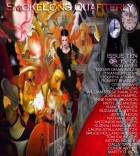That’s some arrival. How does your process work? Did you know about that arrival before you began?
To answer the second part first—absolutely. I knew how this story would end before I began writing. I’ve always been struck by a quote by Flannery O’Connor—the one where she essentially said that often she didn’t know exactly where a story was going when she began. Occasionally I work like this, and I have been surprised by some of what I’ve discovered approaching fiction from this more improvisational angle. However, usually I have a story mapped out in my head or in my notebook before I begin, and then I often find myself discovering new aspects of the story/characters as I go. Still, so much of writing for me is about the preparation that goes into a story before I even put pen to paper. I often find myself drawn to character sketches first as a means to understanding the characters from the inside out first. In a sense I like being inside the skin of my characters first, allowing myself to walk in their shoes. I’m not sure if this is a method acting approach to writing exactly, but it is at least a kissing cousin. I also love to immerse myself in research as a way to get inside the head of a given character and to allow the full context of a story to come to fruition. “Arrival” was an “easy birth,” so to speak, in that it was based not so much on a single arrival as images from a series of recurring arrivals that I experienced growing up. I felt like I knew the narrator here already.
How did your own childhood experiences come into play here?
Growing up in Maryland in what was essentially a hippie household, my father was an avid practitioner of TM (transcendental meditation). Often he would bring his mentor—swamis and yogis usually—to stay with us. This story is based on the painstaking preparation that I always saw my mother enact prior to the arrival of a holy man. In retrospect, her work often felt overlooked to me. It’s true: often the dietary restrictions, for starters, for the various holy men were quite extensive. My mother never shied away from doing all that she could to prepare the house so that my father’s mentors felt at home.
The narrator has seen the light. How important are such moments in flash fiction?
Vital. I don’t think an epiphany is necessary in flash fiction (or in short fiction for that matter). However, like short fiction, the best flash fiction has to imply at least some kind of change–in my view flash fiction just inevitably works on the iceberg principle. A vignette is not enough. This makes writing flash fiction for me both a challenge and something really worth doing. I know for some writers flash fiction doesn’t seem as “serious” as short fiction. On the contrary, I think writing good flash fiction is actually more difficult. Flash fiction is also something that I take on actively, not just as something to write when I don’t have time to write a full-length story. I hope I practice what I preach—I’ve written a book of flash fiction myself that will apparently be coming out in 06 with Ravenna Press.
As fiction editor of The Pedestal Magazine, you’ve seen many a fiction submission. Any advice for writers?
Well, I see a little bit of everything at Pedestal, and I could probably go on and on with do’s and don’ts. My main concerns these days are two fold. First, with the increase in writing markets over the past ten years, far too many writers are seeking publication who really need to hone their craft first. Much of the work I see at Pedestal is top-notch, but some of the submissions seem rushed, harried. Writers need to take their craft seriously—hone the language. Perhaps more importantly I’m disturbed by the current trend in writing away from authenticity, away from anything approximating a truthful account of the world we live in as it really is. The problem isn’t just genre writing—which almost always flees from authenticit—you can also see this in the increasing number of new novels that delve into historical settings. What fiction needs right now is a French New Wave style uprising, a group of writers who say that our goal as fiction writers should be capturing the world and its inhabitants today as it is right now in 2005 without the baroque frills and excesses of the David Foster Wallaces and the like, and especially without resorting to a kind of nostalgia for a time long gone vis a vie historical fiction. Fiction needs to get back to its roots—to become leaner and less stylized.
Your next collection of stories, Drivers, will be appearing soon. How did that whole business go?—and can you give us a preview?
Yes, the book is slated for a December 15th release by Hamilton Stone Editions. At this point in my career, I’m very much a small press author, which in many ways allows me to take the high road—I haven’t sold out, at least not yet! The Hamilton Stone folks have been wonderful to work with, as was Uccelli Press (which put out my 2003 book of stories, A Cold Glass of Milk). Drivers is thematically oriented—all the stories revolve around cars in some way. When I first began writing these stories I was driving around the DC Beltway and up and down Route 95 quite a bit and to essentially steer myself away from road rage I would think of various stories that revolve around cars. A few of these car stories appeared in A Cold Glass of Milk, and Drivers features the other 23 stories on this theme. Essentially I was interested in car stories because of what I felt could show about various characters and especially American culture and ethics through cars. Something seemingly insignificant like driving habits reveals a whole lot about a person, and a society.
Half of Drivers is composed of full length fiction and half of the book is flash fiction, and I structured the collection so that the full length stories would be interspersed with the flash fiction.



 The SmokeLong Grand Micro Contest (The Mikey) is now an annual competition celebrating and compensating the best micro fiction and nonfiction online.
The SmokeLong Grand Micro Contest (The Mikey) is now an annual competition celebrating and compensating the best micro fiction and nonfiction online.